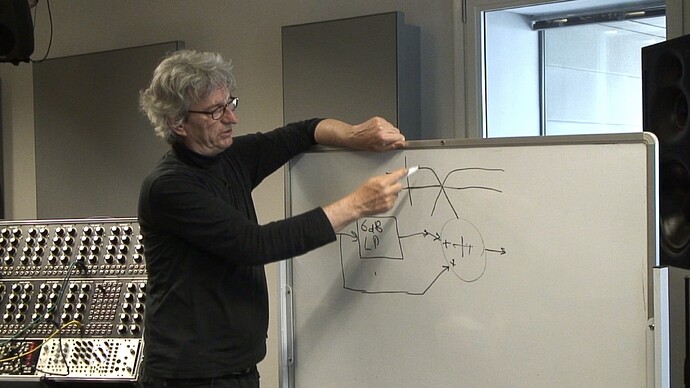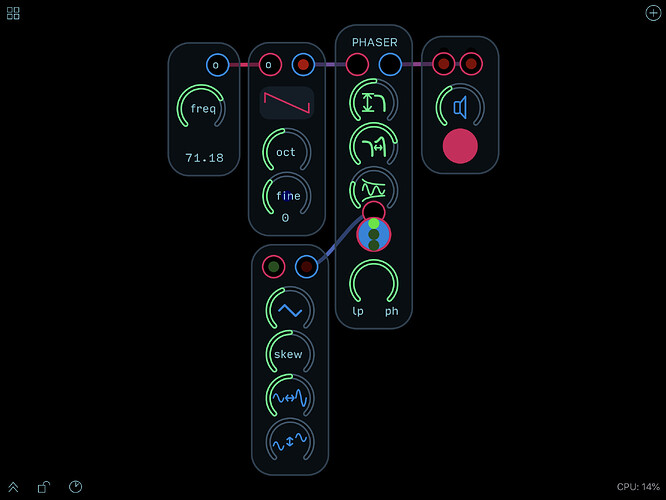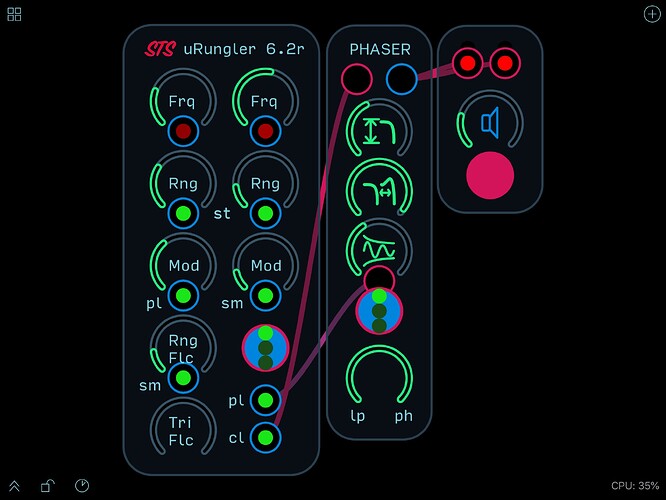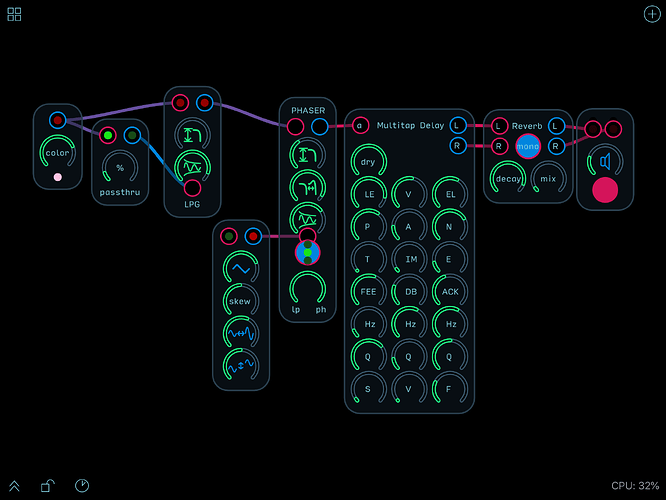This is a repost of part of a thread on the old forum.
After taking a look at the NOVARS Rob Hordijk tutorials on the Physics of Sound and his Dual Phaser, I was keen to try out some of the ideas in Audulus myself.
The Physics of Sound video takes a look at phase shifting and All Pass Filters, and as a tryout I used the 1 Pole LPF in the Audulus library as a starting point for an APF with nice resonant qualities, and then used that as a point of departure for putting together a phaser along the lines of Hordijk’s Dual Phaser. He adds some nice touches such as a switch that flips the direction of half of the modulation input, or keeps half of it static while the other half moves, as well as a fader between the LP and Phaser modes.
RH-RM Phaser.audulus (154.2 KB)
I find the nicest thing is being able to push up resonance and then trigger the phaser with sub-audio pulses for some nice percussive sounds.
Some quick demos:
RH-RM Phaser Demo.audulus (198.1 KB)
RH-RM Phaser Res Rungler Demo .audulus (249.9 KB)
3 Likes
I have been wrapping my head around this diagram, wanting to call phase modulation a way of shifting the point of interest or reading time, where time is a measure, treating the measure in a bi-directional amount. It is easy to think of phase between two audible signals, but I believe it is much harder to conceive of PM as a simultaneity that includes variability.
Is it possible to fold time? Well, what is time?
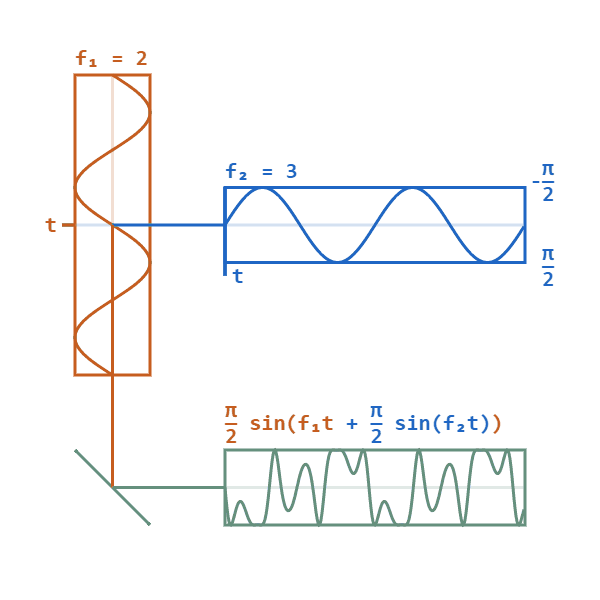
1 Like
It’s a great diagram that seems to have inspired some poetic thoughts on your part. 
Remember that the phaser works on the principle of phase shifts that result in cancellations (or reinforcements) – in that way filtering (or creating resonance) around certain frequencies. Hordijk explains it well in the Physics of Sound video.
Phase Modulation is another technique. @RobertSyrett covers it well in his Know your Nodes video on Phase Modulation. (Which I see you’ve already come across.)
2 Likes
“Phase Modulation is another technique.” Yeah, I thought of putting this comment in your Harmonic Oscillator post because he starts to talk about 3D sound. There have been other more direct posts as well.
As far as the “poetry” goes – I actually fall to the side of science that sees metaphor as inseparable from understanding. I think is it misguided to too quickly think that because you know that one parameter modulates another parameter, you understand the perceived event. We do not actually experience numbers and sound is not audible without the passing of time. I feel like Hordijk is approaching some of these ideas. A waveform diagram is a representation of a set of relations among values. The diagram above seemed fitting in the way phase is perceived, such that we are not dead listeners, but can shift out point of interest – self modulating our awareness along the present-past in either direction.
Without taking the past into account and relating it to the occurance of a minor note, for example, the minor note would not make sense musically. I think that similar free-time scanning occurs at the level of waveform perception. But I could be totally out to lunch. 
3 Likes
You’re right that there’s a scientific side to this – one that Hordijk touches on in his explanation of RMS curves based on the level of the “surface of the sound over time” in his video on the Dual Fader (from around 5mins):
2 Likes
This is a nice phaser for rain. As I am sure you are aware, buttons don,t retain their settings when you exit a patch. You may want to switch your button on the phaser for another knob as @robertsyrett did in his Reitculated Gate Seq V2. The rain sounds best with the button in the middle position.
Rain.audulus (386.9 KB)
2 Likes
Nice!
Yes, I’m aware of the switch not retaining its state. I’ve nevertheless chosen to keep using the switch (on this and other modules) rather than the knob since I like being able to quickly change modes with a tap rather than dragging to change the knob. It feels different.
I’ll look into make a switch that retains its state. You’re welcome to replace the switch with a knob though if that suits you better. That’s the great thing about Audulus – that it’s so easy to customise things to suit ones own preferences/needs.
2 Likes
Triggers set to toggle mode and knobs both retain their state. These, and the value of numeric expressions, are the only persistent values in Audulus at this point. Unfortunately they are all read-only so far as access from other nodes. I’m really looking forward to some form of read/write storage, ideally some form of array. More flexible storage and the ability to write to knobs and triggers would allow presets to be created since you could store a set of knob and trigger values and then recall them and write to the controls.
1 Like
You’r right. Splines and map nodes as well. I rarely use splines, mostly because of the difficult of setting precise values, but they are also persistent. 
1 Like
Blessed is @jjthrash for developing a tool to turn csv files into splines.
1 Like
